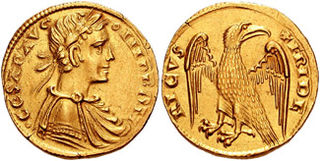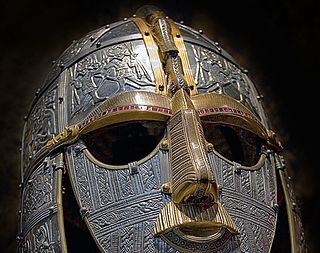
Lucia Travaini (born 1953) is an Italian numismatist, archaeologist, and academic. She is an Associate Professor of Medieval and Modern Numismatics at the University of Milan.

Lucia Travaini (born 1953) is an Italian numismatist, archaeologist, and academic. She is an Associate Professor of Medieval and Modern Numismatics at the University of Milan.
Travaini studied archaeology at the Sapienza University of Rome. She worked for the Soprintendenza Archeologica, the Ministry of Cultural Heritage, and at the National Roman Museum. From 1992 to 1998, she was a senior research associate to Philip Grierson at the Fitzwilliam Museum, University of Cambridge. In 1998, she returned to Italy to join the University of Milan. She also taught at her alma mater between 2002 and 2005. [1] [2] [3] [4]
In 2012, Travaini was awarded the Medal of the Royal Numismatic Society, one of the highest awards for numismatists. [5] In 2014, she was awarded the Prix Duchalais by the Académie des Inscriptions et Belles-Lettres for her book Le zecche italiane fino all'Unità (published 2011). [6] In 2016, she was elected an honorary member of the Royal Numismatic Society of Belgium. [7]

Roger III, of the House of Hauteville, was the eldest son and heir of King Tancred of Sicily and Queen Sibylla. He was made Duke of Apulia, probably in 1189, shortly after his father's accession. In the summer of 1192 he was crowned co-king with his father. Follari were minted at Messina bearing both Tancred's and Roger's names as kings.

An augustalis or augustale, also agostaro, was a gold coin minted in the Kingdom of Sicily beginning in 1231.

Charles IV, Duke of Anjou, also Charles of Maine, Count of Le Maine and Guise, was the son of the Angevin prince Charles of Maine, Count of Maine and Isabelle of Luxembourg-Saint-Pol.

Peter II was the King of Sicily from 1337 until his death, although he was associated with his father as co-ruler from 1321. Peter's father was Frederick III of Sicily and his mother was Eleanor, a daughter of Charles II of Naples. His reign was marked by strife between the throne and the nobility, especially the old families of Ventimiglia, Palizzi and Chiaramonte, and by war between Sicily and Naples.
Tancred of Hauteville, the second son of King Roger II of Sicily and his first wife, Elvira of Castile, was the Prince of Bari and Taranto from 1132 to 1138.

Eleanor of Anjou was Queen of Sicily as the wife of King Frederick II of Sicily. She was a member of the Capetian House of Anjou by birth.
Jonathan, a member of a cadet branch of the Drengot family, was the Duke of Gaeta from 1113 until his death. He is known from the Codex Caietanus to have been in the fourth year of his minority in 1116 and the seventh of his rule in 1119. There are three theories of his paternity. He may have been the son of Count Jonathan I of Carinola or his grandson by an unnamed son, or else the grandson of Count Bartholomew of Carinola. He was under the regency of his cousin or uncle, Count Richard of Carinola.
Philip Grierson, was a British historian and numismatist. He was Professor of Numismatics at Cambridge University and a fellow of Gonville and Caius College for over seventy years. During his long and extremely prolific academic career, he built the world's foremost representative collection of medieval coins, wrote very extensively on the subject, brought it to much wider attention in the historical community and filled important curatorial and teaching posts in Cambridge, Brussels and Washington DC.

Tarì was the Christian designation of a type of gold coin of Islamic origin minted in Sicily, Malta and Southern Italy from about 913 to the 13th century.
Fulco of Basacers was an Italo-Norman knight and landholder with considerable possessions in the Val di Crati in Calabria. The seat of his lordship was "Brahalla", a place or castle that no longer exists.
The gigliato, also gillat or carlino, was a coin of pure silver established in 1303 by Charles II of Anjou in Naples, and then also in Provence from 1330. Its name derives from the Lilies ("giglio") depicted on the reverse entwined around a cross. The coin weighed 4 grams. This type of coin was widely copied in the Eastern Mediterranean, especially by the Turks, such as the Emir of Saruhan.

Coinage in Anglo-Saxon England refers to the use of coins, either for monetary value or for other purposes, in Anglo-Saxon England.
Harold Mattingly was a British classical scholar, specialising in art history and numismatics. His interests included the history of Ancient Rome, Etruscan and Roman currency, and the Roman historian Tacitus.

Frederic, Count of Luna, was a contender for the crown of Aragon.

The trifollaro or trifollaris was a copper coin minted in southern Italy under the Normans. It was worth 120 nummi or 3 folles. The name trifollaro, used by scholars, was coined by the Italian numismatist Rodolfo Spahr. Contemporary sources do not use the name. Spahr interpreted the phrase tres follares aereos romesinam unam appretiatos in Falco of Benevento's discussion of the currency reform of 1140 as a reference to a new denomination of coin.
Events during the year 1190 in Italy.

Medieval European Coinage is a book series on medieval coins published by Cambridge University Press in association with the Fitzwilliam Museum, Cambridge. The project was the idea of professor Philip Grierson (1910-2006) and Mark Blackburn (1953-2011) was the first general editor. It will cover the coinages of Europe for the period c.450-1500. It has been described as the "first comprehensive survey of European medieval coinages since the Traité de numismatique du moyen âge of Engel and Serrure" (1891-1905).
The Traité de numismatique du moyen âge was a survey of European medieval coinage by Arthur Engel (1855-1935) and Raymond Serrure (1862-99) issued in three volumes between 1891 and 1905. Arthur Engel was an archaeologist and numismatist, a member of the French Society of Numismatics and the Society of Antiquarians. He was also a member of the French Schools in Rome and Athens. Raymond Surrure's father and grandfather had been noted numismatists. He traded as a coin dealer in Paris and after his death his widow carried on his business until 1913.

The Mirandola mint, also known as the mint of the Pico della Mirandola, was the mint of the Duchy of Mirandola.
The St Leonard's Place hoard was a hoard of c. 10,000 early medieval Northumbrian coins known as stycas, discovered by workers during construction work at St Leonard's Place in York in 1842. Many of the coins were subsequently acquired by the Yorkshire Museum.